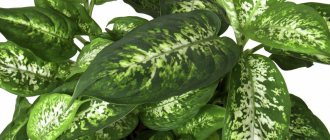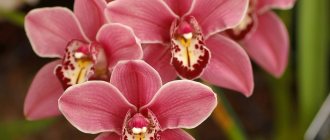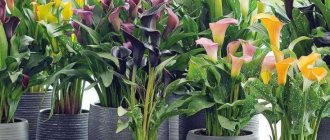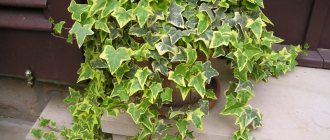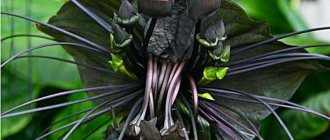Dieffenbachia is an evergreen plant that is of interest to those who like to decorate apartments and garden plots. The flower was named in honor of Joseph Dieffenbach, who served as the head gardener of the Austrian Imperial Botanical Garden in the 19th century. Thanks to its variegated leaves, the plant is often used as an indoor plant. However, its poisonous properties cast doubt on the advisability of such a neighborhood.
What kind of plant is this, is it possible to keep Dieffenbachia at home, how is it dangerous for humans and is there any benefit from it? - let's find out. And also what to do if your skin or eyes are burned by Dieffenbachia juice and if you have food poisoning.
Botanical description
Dieffenbachia belongs to the genus of evergreen plants of the Araceae family. It has a developed root system and a thick juicy stem. When grown at home, its height reaches from 0.5 to 2 m.
Dieffenbachia leaves have an oblong shape and are alternately arranged on the stem. They are painted yellow-green, which is beautifully set off by a marble pattern of spots or stripes. Drops of liquid periodically appear at the tips of Dieffenbachia leaves; these “tears” indicate increased air humidity and can predict imminent rain.
Dieffenbachia blooms in the spring, usually in April or May. But when kept at home, this rarely happens. The decorative value of Dieffenbachia is associated with the variegated pattern of the leaves. The small flowers, collected in a spadix, have an attractive yellowish-white hue.
Dieffenbachia is a poisonous plant. Its species that can cause intoxication, and are often grown at home, are as follows.
- Variegated Dieffenbachia - has a characteristic marble pattern of light spots and stripes.
- Oersted - leaves painted a solid green color with a white streak in the middle.
- Spotted Dieffenbachia - its name comes from its large light spots.
- Leopolda - dark green leaves with light veins.
- Lovely Dieffenbachia - decorated with large leaves up to 50 cm and a tall stem up to 1.5 m.
- White flame - the leaf pattern resembles tongues of fire.
The systematization of Dieffenbachia varieties is very confusing. However, the beginning of existing ornamental plants was laid by the selection of two varieties - spotted and variegated.
In nature, Dieffenbachia grows in the tropical forests of South and Central America.
Plant characteristics
This beautiful evergreen shrub, belonging to the aroid family, is native to the South American continent. In its natural environment, this flower has a fairly high growth rate and can reach a height of about 2 meters; it is almost impossible to achieve such a height when kept at home.
Dieffenbachia is so beloved by housewives because of its spectacular appearance; the plant has large leaves with a peculiar spotted color. Despite the fact that the flower can be found not only in apartments, but also in public organizations, it is quite capricious and demanding to care for.
In order for the plant to feel comfortable, the room will need to create favorable lighting and maintain temperature conditions. Only in this case will the bush develop normally and grow quickly.
Beneficial features
The history of Dieffenbachia cultivation is almost two hundred years old. Such a long acquaintance allowed us to study the plant in many ways, including as an object for decorative use at home.
Useful properties of Dieffenbachia:
- regulates indoor air humidity, promotes dust settling on the surface;
- releases phytoncides - biological active substances that suppress the growth and development of pathogenic bacteria;
- absorbs harmful components of exhaust gases;
- neutralizes toxic substances contained in finishing materials of residential premises, cleaning products and detergents.
However, the positive qualities of Dieffenbachia do not negate the danger of this plant, since its juice contains poison. It contains oxalic acid, its derivative calcium oxalate, alkaloids, and essential oils. The flower can cause significant harm to the health of people and pets.
When is it better to avoid this plant in an apartment?
Experts confirm that this flower contains a hidden threat to health. That is why, if you want to acquire one, you need to think about how the plant will be maintained and whether it will harm any of the family members. It is strongly recommended to refuse to keep the plant in the apartment if you have:
- Small children. A child who is unaware of the dangers of the flower may want to play with it or taste the leaves, which will lead to swelling of the larynx and loss of consciousness. Since a child’s body is more vulnerable and unprotected, the poison of the plant will cause much more harm to the baby than to an adult. The consequences of such inattention can be very serious, including the development of heart failure;
- Pets. Most cats and dogs also like to taste houseplants; Dieffenbachia in this case is extremely harmful. If the animal is small, the ingestion of a large amount of juice can cause swelling of the laryngeal mucosa and cause death from lack of air.
Why is Dieffenbachia flower dangerous for humans?
Oxalic acid harms biological tissues of the body. It has a destructive effect upon contact with the skin, mucous membrane of the mouth, pharynx and larynx. It is based on irritation followed by inflammation and the appearance of a chemical burn reaction. There is evidence that the volatile components of Dieffenbachia juice can provoke irritation of the nasal mucosa, upper respiratory tract, eyes, and headaches.
Dieffenbachia can cause allergies. The risk group includes people with reactions to dust, pets, and citrus fruits.
When processing a plant without using gloves, the poisonous juice from the hands gets into the mucous membrane of the eyes.
Dieffenbachia leaves and flowers can be unintentionally eaten by a child. Pets are at the same risk.
Esotericists believe that Dieffenbachia is included in the list of plants that can change the energetic atmosphere of a home. Energy practitioners attribute the following properties to it:
- disrupts the harmony in the relationship of married couples;
- negatively affects potency in men, leading to infertility;
- prevents girls from matrimonial plans;
- extinguishes the negative energy of quarrels and family discord.
Such information may seem contradictory and exaggerated. However, it is worth remembering that the flower is popularly called muzhegon; it is perceived as a symbol of celibacy. Therefore, it cannot be ruled out that Dieffenbachia, which is poisonous to humans, releases substances that negatively affect reproductive function during prolonged contact.
Why is Dieffenbachia dangerous?
Signs and mystical properties of the plant
Esotericists endowed the houseplant with special energy, which can be both positive and negative. And signs are also divided into two groups. It all depends on where the pot with the indoor plant is located.
Thanks to its signs, Dieffenbachia is also called “widow’s flower” and muzhegon. If you believe superstition, then you should not keep a tropical bush as a houseplant:
- unmarried - risk of not starting a family;
- for married couples – divorce is possible;
- in a house where there are animals, the pets will run away.
The plant causes a lot of trouble for men, as it is considered a female flower. Infertility, problems with potency, difficulties at work, quarrels with his wife - all this is promised by the South American beauty if the owner takes care of her. To avoid all this, it is better to entrust Dieffenbachia to female hands.
Negative effects also include sleep disturbance, deterioration of financial condition (even poverty), the appearance of irritability, and heart pain. But experts assure that Dieffenbachia is not to blame for these health disorders.
Dieffenbachia has bloomed - what is it for?
Seeing flowering does not always happen: it happens rarely. But there is no need to worry about this. Bioenergetics specialists call the Dieffenbachia flower a harbinger of the accumulation of negative energy in the house. The plant thus communicates the need for change.
in the photo there is a blooming diefenbachia
Gardeners recommend cutting off the bud while it is still emerging. This will be beneficial, because energy will not be spent on growth and leaves may fall off. Considering that there is no beauty in a flower, it is worth listening to the advice of gardeners.
Why does Dieffenbachia cry?
The plant is often called a natural barometer. Since it is native to the tropics, it can predict heavy rainfall. The “crying” of dieffenfachia is a way to get rid of excess moisture in advance so that the soil does not become waterlogged during rains or snowfalls.
When Dieffenbachia cries, this is how it gets rid of excess moisture
Causes of Dieffenbachia poisoning
Intoxication can occur:
- through the skin;
- mucous membranes;
- by inhalation;
- by the food route when it enters the gastrointestinal tract.
Most cases of Dieffenbachia poisoning occur through contact with skin or mucous membranes. You can usually avoid the plant's toxic effects by being careful, but children and pets are always the weak link. They may use an unconventional method to become acquainted with an attractive flower - chew parts of the plant, pick off the leaves, and then rub their eyes.
When bringing Dieffenbachia into the house, adults should be aware that their child can be poisoned by a poisonous plant, suffering a burn to the skin, eyes, mucous membranes, or digestive upset.
Is it possible to keep Dieffenbachia at home?
If you already have indoor plants at home, then in this case you need to remember that Dieffenbachia gets along very poorly with other representatives of the flora. It should be assigned to a separate room. Otherwise, discord in the family cannot be avoided.
To ensure that proximity to a flower does not bring problems, it is highly undesirable to place it in the room where a married couple sleeps. Dieffenbachia can be placed in the kitchen: here it will prevent quarrels and conflict situations.
Dieffenbachia is a kind of indicator of the accumulation of negativity. And if you place a flower in an unfavorable zone, it will absorb flows of negative energy and cleanse the aura in the room.
The best place for Dieffenbachia in an apartment would be a study or any other area where business or study is usually done. As the signs say, this plant strengthens business acumen and helps in solving complex problems, and therefore a place near your computer will be the most suitable.
The best place for Dieffenbachia in an apartment would be a study or any other area where business or study is usually done.
Skin burn
The poisonous juice of Dieffenbachia comes into contact with unprotected tissues during processing of the plant, cutting off leaves, stems, and peduncles. Therefore, in order to avoid poisoning, any interaction with the flower must be carried out with gloves.
Symptoms will resemble a skin burn:
- acute pain;
- burning, itching;
- redness, swelling of the site of contact with the poison.
How to treat a skin burn from exposure to Dieffenbachia? It is enough to quickly wash off the juice with running water, including rinsing your mouth and nose. Do not rub the skin in an attempt to completely remove the aggressive substance. For severe pain, you can take a drug with an analgesic effect.
Popular speculation
Often, plants can be purchased based only on signs about them. A living tree is to improve the financial side of life, geranium is to ward off the evil eye, but the “heroine” of our article was immediately unlucky in this sense. Not yet knowing whether Dieffenbachia is poisonous or not, already unpleasant properties were attributed to it. The poor thing was called the flower of celibacy, endowing her with the ability to get rid of the owner in the room where she is. And if an unmarried lady decides to bring this flower into her apartment, seduced by its lovely wide leaves, then she will not find a soul mate forever and ever. Dieffenbachia is a poisonous “friend,” according to popular superstition; she will turn her owner into a divorcee or, worse, a widow in no time. Scary? But if you turn on prudence, you can remember more than one happy family that has the above-mentioned plant.
Superstitious people are very wary of the flowering of Dieffenbachia. As soon as she released the arrow, the owner of the house is deprived of his masculine strength, they think. Some go further and reinforce the horror story with the fact that if a couple has this flower and it suddenly puts out an ear, then the unfortunate people will not have children until they evict the innocent plant from the apartment.
Another legend is also associated with the flowering of Dieffenbachia. It is generally accepted that it occurs if there is a nervous atmosphere in the room. Frequent quarrels and scandals supposedly contribute to the appearance of a flower-cob. But these rumors have no scientific basis and are just popular speculation. A sane person understands that any plant blooms when external factors, similar to conditions in the wild, contribute to this.
Burn of mucous membrane
A special case when toxic substances settle on the mucous membrane of the nose, oral cavity, and larynx. Signs of Dieffenbachia poisoning indicate acute respiratory failure:
- burning sensation, pain, soreness;
- increased respiratory movements;
- dry whistling cough;
- dyspnea.
If swelling of the mucous membrane causes obstruction of the respiratory tract, there is a threat to human life. Symptoms of insufficient oxygen supply to the body may appear:
- bluish skin;
- depression of consciousness;
- decreased blood pressure;
- development of a terminal condition.
It is necessary to immediately call an ambulance and do not leave the victim alone until medical specialists arrive. Monitor his consciousness, breathing, blood pressure, heart rate. If a terminal condition develops, begin cardiopulmonary resuscitation.
If Dieffenbachia juice gets into the eyes, a burn appears, the depth of which may vary. The severity depends on the concentration and time of exposure to the damaging factor. The victim may complain of pain, burning, swelling, inability to open the affected eye, lacrimation, and blurred vision.
What to do if your eyes are burned by Dieffenbachia juice?
- Rinse the cavity with a stream of water so that the liquid does not get on the healthy side, applying a protective bandage to the unaffected eye (especially important for children).
- Seek medical attention immediately.
A hardware and clinical examination will be carried out at the emergency room. Only a medical specialist can adequately assess the depth of the lesion. The doctor will prescribe a comprehensive treatment - analgesics, if there are indications - antibacterial, healing drugs, physiotherapeutic procedures. If necessary, the victim is hospitalized in a hospital.
Energy potential of a flower
Many housewives strive to have as many plants as possible at home, without paying attention to their properties and energy potential. If you like Dieffenbachia, its care will be minimal. It is unpretentious to light, humidity and soil. That is why many housewives choose it to decorate their home, without taking into account its magical and energetic properties.
All indoor plants can be divided into those that are capable of giving off energy and those that absorb it. What group does Dieffenbachia belong to? The energy of this plant is prone to absorption from the outside - that is, it is a kind of “vampire”. It absorbs human energy, which leads to the following consequences:
- causeless aggression;
- fatigue;
- health problems;
- weaknesses;
- feeling unwell.
You can compensate for this by placing the plant in a spacious room. It is best to keep it in an area where a person does not stay for a long time, away from sofas and armchairs in which he likes to relax.
Allergy to Dieffenbachia
What to do if Dieffenbachia juice gets on your skin and causes an allergic reaction? Symptoms can be divided into local and general.
If a localized rash, itching, or blisters appears, take antihistamines and monitor the body's reaction. If further development of symptoms does not occur, then the following conclusions should be drawn:
- the impact was local;
- next time the reaction will be more violent and unpredictable.
General symptoms occur with the development of acute respiratory and cardiovascular failure. The severity of the condition requires immediate hospitalization and intensive care in the intensive care unit.
Recommendations for care so that the flower provides benefits
- A woman needs to take care of a flower, because its magic resonates with feminine energy.
- A location near a window, slightly in the shade, and regular watering, which will ensure the soil is constantly slightly moist, are excellent conditions for the flower’s full strength to be revealed.
- Think carefully about which room to place the plant in: you will protect your loved ones and get the maximum positive result.
- The care shown to the plant will provide a doubly return in the form of a positive impact.
Food poisoning
If you eat parts of the Dieffenbachia plant, it will initially show signs of burning. These include:
- pain, burning, itching, tingling;
- in the case of children - motor and emotional agitation, inability to come to an agreement or fulfill requests;
- swelling and redness of the lips, oral mucosa;
- increased salivation;
- difficulty breathing, swallowing, producing sounds (speech).
Later the symptoms of food poisoning appear:
- nausea;
- vomit;
- pain;
- pain in the stomach area;
- diarrhea (frequent loose stools).
What to do in case of Dieffenbachia food poisoning, for example, if a child has eaten a poisonous plant? Immediate medical attention will help neutralize the toxic substance. Independent lavage of the stomach and even the oral cavity can cause complications in the form of aspiration (flow of gastric contents into the respiratory tract) and spread of the burn area. This occurs against the background of difficulty swallowing, breathing, and the inability to communicate calmly. Severe sudden pain causes fear and inappropriate behavior of the child. Before the ambulance arrives, adults should distract him and provide psychological support.
Specialized treatment for Dieffenbachia food poisoning includes:
- adequate pain relief;
- hardware diagnostics (FGDS);
- gastric lavage;
- infusion (intravenous drip) of saline solutions;
- respiratory therapy - humidified oxygen, artificial ventilation;
- correction of gastrointestinal tract functions;
- prevention of complications.
The prognosis for the development of complications after Dieffenbachia food poisoning depends on how soon intensive therapy is started. The decisive factor in the fight against poison is time. Rapid removal of toxins from the gastrointestinal tract significantly reduces their absorption.
Improving the indoor microclimate
It has been found that the number of pathogenic microbes in the air decreases if Dieffenbachia grows in your home. Benefit and harm are the most important characteristics that you need to know about in order to do something. The plant is also capable of secreting natural phytoncides, which deactivate staphylococcus and some other microorganisms.
Get Dieffenbachia if there are people in your home who suffer from allergies. Since the plant requires constant spraying, the humidity level in the room increases and there is much less dust.
How a flower can influence a young couple
There are several names for Dieffenbachia:
- muzhegon;
- widow's flower;
- barren flower.
Young and unmarried girls are not recommended to place pots of Dieffenbachia in their home. Signs claim that his strong energy will lead to a break in relationships in a couple, betrayal and frequent scandals. Also, the flower can negatively affect male strength and female fertility.
Why does Dieffenbachia bloom?
In our climate, the tropical plant blooms extremely rarely. For this to happen, several conditions regarding care, temperature and humidity levels must coincide. When Dieffenbachia blooms, this is an indicator that the energy situation in the family or team has worsened. Such an event can warn of imminent unpleasant changes and deterioration of relationships.
From an energetic point of view, the flowering of a tropical guest is a sign of change. Even if they are negative, they can later change your life for the better.
What Feng Shui says about Dieffenbachias
Feng Shui masters speak positively about the flower, as the plant has strong energy. When placed correctly it is capable of:
- optimize the indoor microclimate;
- create a working atmosphere in the office;
- reveal maximum abilities.
At the same time, the teachings of Feng Shui do not recommend placing Dieffenbachia in residential areas; it recommends using them in the office, placing them in the northwestern part of it.
Esotericists believe that only healthy plants should be kept indoors. If it withers, then you should throw it away without regret. Astrologers recommend having Dieffenbachia for Leos and Cancers; it suits them from an energetic point of view.
